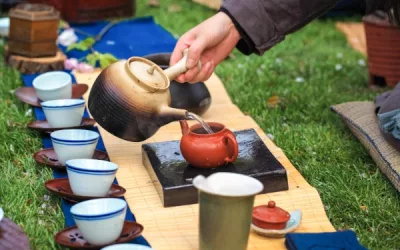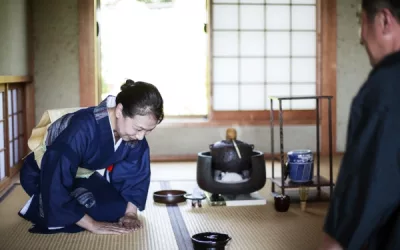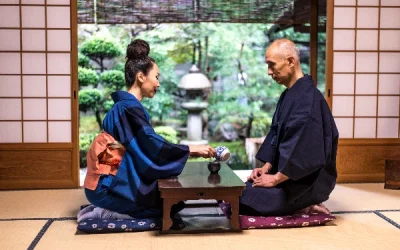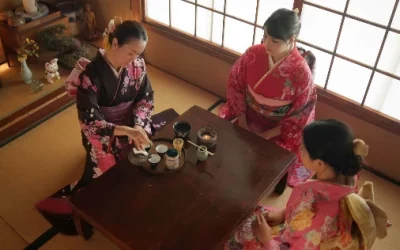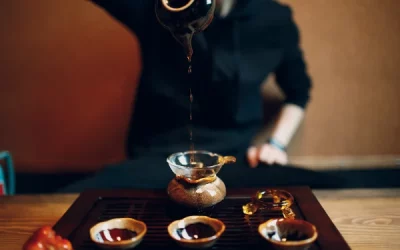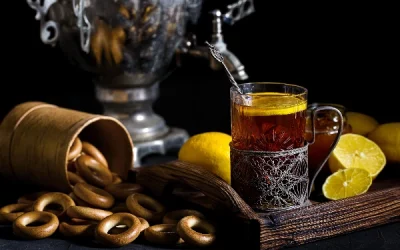Ever wondered how a simple cup of tea can transform into a mindful ritual? The Gong Fu Cha tea ceremony embodies more than just brewing tea; it’s a profound cultural practice rooted in precision, skill, and connection. In an age where mindfulness is increasingly relevant, understanding Gong Fu Cha offers a unique path to enrich our tea-drinking experiences and deepen our appreciation of Chinese traditions. This comprehensive guide will walk you through the essentials of mastering Gong Fu Cha, from equipment and techniques to the profound impact of mindfulness in this exquisite ceremony.
Table of Content
- What is Gong Fu Cha?
- What equipment is needed for a Gong Fu Cha ceremony?
- What are the steps involved in performing a Gong Fu Cha ceremony?
- How do you select the best teas for Gong Fu Cha?
- What role does mindfulness play in Gong Fu Cha?
- How can one adapt Gong Fu Cha for modern settings?
- What are common mistakes to avoid in Gong Fu Cha?
- How does Gong Fu Cha contribute to cultural appreciation?
- Conclusion
What is Gong Fu Cha?
Gong Fu Cha, often translated as the “Art of Tea,” is a traditional Chinese tea ceremony that focuses on brewing tea with precision and skill. Originating from the regions of Fujian and Guangdong in China, it embodies a rich cultural heritage and a deep connection to Chinese philosophy.
Unlike more casual tea brewing methods, Gong Fu Cha places a strong emphasis on the quality of the tea leaves, water temperature, and the brewing process itself, ensuring a refined and highly enjoyable tea-drinking experience.
The ceremony is not just about drinking tea; it’s a meditative practice that encourages mindfulness and presence.
The Gong Fu Cha philosophy revolves around the idea of achieving excellence through practice, reflecting the literal meaning of “Gong Fu,” which implies skill and effort.
This intricate ceremony uses various types of tea, such as Oolong, Pu-erh, and occasionally green or white teas, each requiring specific brewing techniques to bring out their unique flavours.
What does Gong Fu Cha literally mean?
The term “Gong Fu Cha” translates to “making tea with skill.”
- “Gong Fu” or “Kung Fu” in this context is not related to martial arts but rather denotes the concept of skill, effort, and dedication.
- “Cha” simply means tea in Chinese.
- Together, Gong Fu Cha means a tea ceremony that requires dedication and practice.
In essence, this phrase encapsulates the meticulous nature of the tea-making process. It’s an art form that demands precision, patience, and a bit of flair.
How did Gong Fu Cha evolve over time?
Gong Fu Cha has a long history dating back to the Song Dynasty (960-1279 AD).
- It became more refined during the Ming (1368–1644) and Qing (1644–1912) Dynasties.
- Over time, various tea masters contributed to the practice, enhancing the techniques and tools used.
- The ceremony became a social and cultural activity, especially among the Chinese literati and scholars.
- Modern iterations of Gong Fu Cha still adhere to traditional methods but have also adapted to contemporary tastes and settings.
The evolution of Gong Fu Cha is a testament to China’s enduring love for tea and its role in social and cultural practices. The ceremony has been passed down through generations, preserving its essence while allowing room for innovation.
What are the key differences between Gong Fu Cha and Western tea brewing?
Gong Fu Cha and Western tea brewing are quite distinct in their approaches and philosophies.
- Tea Leaves: Gong Fu Cha uses whole, high-quality leaves, while Western methods often use tea bags.
- Brewing Technique: Gong Fu Cha involves multiple short infusions rather than one long steeping.
- Tools: Gong Fu Cha requires specialised tools like Yixing clay teapots or Gaiwans, whereas Western tea brewing typically uses simpler equipment.
- Serving: In Gong Fu Cha, tea is served in small cups to appreciate the flavour, while Western tea is often served in larger mugs.
- Mindfulness: Gong Fu Cha is a meditative practice, whereas Western tea brewing is generally more utilitarian.
These differences highlight the cultural nuances in tea appreciation and preparation between the East and the West.
Gong Fu Cha is not just a method of making tea; it’s a way of life that encourages mindfulness and an appreciation for the finer details. The ceremony has a storied history, evolving through centuries while retaining its core principles.
In the Qing Dynasty, Emperor Qianlong was known for his love of tea and often practised Gong Fu Cha. He even wrote poems about the art of tea, illustrating its importance in Chinese culture. His patronage helped popularise the ceremony, making it a staple in Chinese households and an integral part of social gatherings.
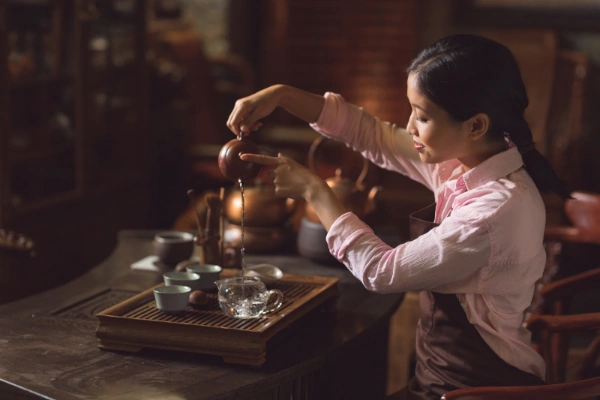
What equipment is needed for a Gong Fu Cha ceremony?
Performing a Gong Fu Cha ceremony requires a specific set of tools and utensils designed to enhance the tea’s flavour and aroma. Let’s take a closer look at each piece of equipment and its purpose. The following table provides an overview of these essentials, along with recommended materials for each.
Equipment for Gong Fu Cha Ceremony
Understanding the role of each tool and using the recommended materials can help you enjoy an authentic Gong Fu Cha experience. Here’s a handy table to guide you:
| Equipment Name | Purpose | Recommended Materials |
|---|---|---|
| Tea Tray | Collects spillage | Wood, Bamboo |
| Tea Pot | Brews the tea | Yixing Clay, Porcelain |
| Gaiwan | Alternates with tea pot for brewing | Porcelain, Glass |
| Tea Cups | Serves tea to drink | Porcelain, Ceramic |
| Fairness Pitcher | Ensures even distribution of tea | Glass, Porcelain |
| Tea Strainer | Filters out tea leaves | Stainless Steel, Mesh |
| Tea Tongs | Handles hot tea cups | Bamboo, Wood |
| Tea Scoop | Measures out tea leaves | Bamboo, Wood |
| Tea Needle | Clears spout of tea pot | Bamboo, Wood |
| Tea Pet | Decorative, absorbs tea for luck | Clay, Ceramic |
Using this table, you can gather the necessary equipment and understand their significance in the ceremony. Let’s delve deeper into some of these tools and tips on using them effectively.
How to use a tea tray
A tea tray is an essential part of the Gong Fu Cha ceremony. It helps to manage and collect any water or tea that spills during the brewing process. To use a tea tray:
- Place it on a stable surface.
- Position all your brewing tools and cups on the tray.
- Allow any overflow or spillage to be absorbed by the tray.
The tea tray not only keeps your area clean but also adds to the aesthetic appeal of the ceremony.
How to use a gaiwan
A Gaiwan, or lidded bowl, is a versatile tool in brewing tea during the ceremony. Here’s how you can use it:
- Measure out tea leaves using a tea scoop.
- Add the leaves to the Gaiwan.
- Pour hot water into the Gaiwan over the leaves.
- Use the lid to move the leaves around and control brewing.
- Pour the brewed tea into a fairness pitcher.
Using a Gaiwan allows for precise control over the brewing time, ensuring optimal flavour extraction.
How to use a fairness pitcher
The fairness pitcher, or cha hai, ensures that each guest receives tea of consistent strength. Here’s how to use it:
- After brewing, pour the tea from the Gaiwan or tea pot into the fairness pitcher.
- Distribute the tea evenly into individual cups from the pitcher.
- This step guarantees that everyone enjoys the same quality of tea.
In ancient China, the tea ceremony was a revered practice among scholars and the elite. One significant figure, Lu Yu, often called the “Sage of Tea,” authored “The Classic of Tea” during the Tang Dynasty.
This text documented the intricacies of tea preparation and set a standard for tea culture. His work is still revered, shaping the practices of modern Gong Fu Cha ceremonies.
What are the steps involved in performing a Gong Fu Cha ceremony?
Alright, tea lovers and cultural learners, buckle up! We’re diving into the world of Gong Fu Cha, the Chinese tea ceremony that’s about as intricate as a Swiss watch.
We’re talking measured leaves, just-right temps, and enough small steps to make you think you’re performing a delicate dance. It’s all about turning tea-making into an art form.
The Steps to Master Gong Fu Cha
First things first, let’s get your space ready. You wouldn’t renovate your kitchen without clearing out the clutter, would you? Setting up a serene environment is crucial.
Think zen garden, not teenage bedroom. Start by washing your tea utensils—cleanliness is key here. This not only ensures hygiene but also purifies the tools, prepping them for their noble task.
Measure your tea leaves like you’re reading a recipe from a Michelin-starred chef. No scooping and dumping allowed. Water temperature? Critical.
Get it right, or you could ruin the whole batch. Finally, serve the tea gracefully. You’re not pouring a pint at the local pub; consider this a genteel affair.
What are the initial preparations before starting the ceremony?
Ready to make some tea magic happen? Before you start brewing, you’ve got to prep like a pro boxer heading into the ring.
- Clear the Area: Make sure your tea space is clean and clutter-free. You’re aiming for inner peace here, not a jumbled mess.
- Utensil Rinse: Wash all tea utensils with hot water. Not only does this clean them, but it also pre-heats your tools so the tea brews at the right temperature.
- Set Up Your Tools: Lay everything out neatly. You’ll need a tea tray, teapot, and tea cups. Trust me, the last thing you want is to reach for a teacup and knock over the kettle.
- Mindset Matters: Get your mind into tranquility mode. Think calm thoughts, breathe deeply. If you’re stressed, your tea will be too.
- Tea Selection: Choose your tea leaves carefully. The quality of your tea sets the tone for the entire ceremony.
Getting the area ready isn’t just about having things at hand. It’s a vibe, a level of preparation that says, “I know what I’m doing here.”
How do you determine the right water temperature for different teas?
Alright, let’s talk about water temperature. It’s the unsung hero of a perfect brew. Too hot or too cold, and you’ve got yourself a cup of regret. Each type of tea demands a different level of heat like a diva with specific backstage requirements.
- Green Tea: Aim for about 70-80°C. Anything hotter and you’ll scorch those delicate leaves.
- White Tea: Similar to green, 70-80°C. These leaves are tender and need gentle heat.
- Oolong Tea: This one’s a bit heartier. Go for 85-90°C.
- Black Tea: These guys can handle the heat. 90-100°C.
- Pu-erh Tea: Old and bold, it needs boiling water. A full 100°C.
It’s not just about the numbers on a thermometer. Different teas have unique compositions that respond to varying temperatures, unlocking their best flavours only when you get it right.
What is the significance of each step in the ceremony?
Every step in the Gong Fu Cha ceremony has a purpose. You’re not just hopping from one step to the next; you’re creating a narrative, a history with each brew.
- Preparation of Space: Setting the scene for mindfulness and focus. Think of it as Feng Shui for tea.
- Washing Utensils: This cleanses not just the tools but also prepares them for the delicate task ahead. It’s a symbolic purification.
- Measuring Tea Leaves: This step respects the leaves and the people who picked them. Precision here means you value quality over quantity.
- Water Temperature: Crucial for extracting the perfect flavours and aromas. Different teas, different temps—it’s all about unlocking the best your tea has to offer.
- Serving the Tea: This final flourish is a gesture of hospitality. It’s about sharing something precious with those around you.
Each step is like a verse in a poem. Together, they tell a story of tradition, respect, and meticulous care.
A little historical nugget for our curious minds: The history of Gong Fu Cha goes back to the Qing Dynasty. Emperor Qianlong (1711-1799) was a massive tea enthusiast.
Legend has it that he would disguise himself as a commoner and travel across China to find the best teas. The Gong Fu Cha ceremony, with its detailed focus, is believed to have started under his reign as a way to honour the tea leaves and the people who cultivated them.
So next time you brew, think of yourself as part of a centuries-old tradition with roots branching back to an Emperor’s quest for excellence.
There you go—a comprehensive guide to mastering Gong Fu Cha. Perfect for impressing your friends, finding your inner zen, or just enjoying a superb cup of tea. Cheers!
How do you select the best teas for Gong Fu Cha?
Alright, let’s talk about getting the finest brews for your Gong Fu Cha tea ceremony. You can’t just pick any random leaves and expect a magical experience. Nope, it requires precision, some background knowledge, and a pinch of tea geekery. We’re diving into the types of teas, sourcing premium leaves, tea grades, and how the freshness impacts your cup.
So, buckle up and let’s transform you into a bona fide tea master.
What characteristics should you look for in high-quality tea leaves?
If you’re trying to figure out what makes tea leaves high-quality, you’re halfway to tea enlightenment, my friend. Let’s break it down into some digestible chunks:
- Appearance: In premium teas, the leaves usually have uniformity in size, colour, and shape. If it looks like a hot mess, it might not be the best choice.
- Smell: High-quality leaves should have a strong, fresh aroma. If it smells stale or like the inside of your grandmother’s old handbag, pass on it.
- Feel: The leaves shouldn’t crumble in your hands. If they do, they’re probably too dry or old.
- Grade: Here’s where tea grading comes into play. You’ll often see terms like “first flush,” “special grade,” or “luxury.” Higher grades usually indicate better quality.
- Colour: Depending on the tea type, the color should be vibrant and not dull. Dullness can indicate poor storage or processing.
Inspecting these characteristics helps in making sure you’re brewing something that does justice to the Gong Fu Cha tradition. Now, let’s dig deeper into how the type of tea you select plays a crucial role.
How does the type of tea affect the Gong Fu Cha experience?
If you think one tea fits all, you’re about to get schooled. The type of tea you choose can either make your Gong Fu Cha experience transcendent or just meh.
- Oolong: This tea sits somewhere between green and black tea, offering a complex, rich flavour profile—like your quirky artsy friend who always surprises you.
- Pu erh: Earthy, deep, and aged to perfection. It’s like the granddaddy of teas, full of wisdom and mystery.
- Green: Fresh, light, and vegetal. Imagine sipping springtime in a cup.
- White: Delicate and subtle, these teas offer a mild, sweet flavour, perfect for the laid-back, minimalist vibe.
- Black: Strong and robust, black teas give you that kick you sometimes need to get through a rough day.
By the end of it, the type of tea directly shapes your sensory experience. So don’t just wing it—consider what kind of mood you’re aiming to create.
But where do you even get your hands on these authentic teas? Let’s find out.
What are the best sources to find authentic Gong Fu Cha teas?
Okay, so you know what to look for and understand how tea types affect your ceremony. But where’s the treasure trove of authentic tea leaves?
- Specialty Tea Shops: These retailers often have a curated selection of high-quality and authentic leaves.
- Online Marketplaces: Websites like Yunnan Sourcing or Verdant Tea, which specialize in Gong Fu Cha offerings.
- Tea Farms: Direct-from-the-source purchases ensure what you get is as fresh as it gets. Plus, you’re supporting small farmers.
- Tea Festivals: Yes, these are real! They’re like Comic-Con but for tea lovers. You can sample and purchase from a wide range of vendors.
- Cultural Commerce Sites: Websites like Etsy sometimes have independent sellers offering authentic leaves directly from regions like China and Taiwan.
There you go—a roadmap to finding those aromatic gems that will make your Gong Fu Cha tea ceremony unforgettable.
Now, let’s whisk you back to ancient China. The 8th-century Tang dynasty opened a magical portal for tea lovers. Lu Yu, the godfather of tea culture, wrote “The Classic of Tea,” the first ever monograph on the subject.
Imagine this guy as the Shakespeare of tea. His work standardised tea-making practices and elevated tea culture for centuries to come. Thanks to Lu Yu, we can appreciate the art and subtlety of Gong Fu Cha today.
So as you sip your next cup, raise it to Lu Yu—the original tea influencer.
What role does mindfulness play in Gong Fu Cha?
Alright, folks, let’s talk about mindfulness in the context of Gong Fu Cha, the Chinese tea ceremony that’s more than just a fancy way of brewing leaves. If you’ve ever tried meditating and found your mind wandering to that last embarrassing thing you said in year 7, Gong Fu Cha might be the practice for you! It’s not just about making a cup of tea; it’s about creating a serene bubble in the middle of your hectic life.
Mindfulness in Gong Fu Cha revolves around being fully present throughout the entire ceremony. This means paying attention to every little step, from heating the water to sipping the tea, turning it into an immersive, almost magical experience where time kind of just stops.
How can mindfulness enhance the tea drinking experience?
Mindfulness is like adding a sprinkle of fairy dust to your average tea-drinking session. When you’re fully present, you’re not just drinking tea—you’re engaged in a mini escape from reality.
- Enhanced Flavours: Focusing on the aromas, flavours, and textures can make a simple sip feel like a symphony in your mouth. No, really, try it.
- Stress Reduction: Being mindful has a calming effect, reducing stress and anxiety. Think of it as a spa day, but in a teacup.
- Sensory Engagement: Your senses get a good workout. You notice the steam, the warmth, and even the sound of pouring water.
- Increased Gratitude: Taking time to appreciate the effort and tradition behind Gong Fu Cha can make you more grateful for the simpler things in life.
- Presence: Being in the moment helps you enjoy and appreciate where you are and who you’re with, rather than thinking about tomorrow’s to-do list.
Being present and fully engaged can transform tea drinking from a mundane task into an extraordinary experience. You get to savour every flavour note, which makes each cup feel like a tiny celebration.
What practices can be incorporated to promote mindfulness during the ceremony?
Let’s dive into the nitty-gritty of how to turn your next tea time into a zen-like experience.
- Focused Breathing: Start with a deep breath. Inhale the aroma of the tea and exhale any distractions.
- Purposeful Movements: Perform each step with deliberate care, as if every motion were a dance move in a routine.
- Sensory Exploration: Pay attention to the sight, smell, and sound of each step. Notice the way the tea leaves unfurl, the impact of boiling water on the leaves, and the colours changing.
- Engagement: Talk to your guests, share your thoughts, and discuss the flavours and aromas you’re experiencing. Tea time is storytime.
- Quiet Reflection: Take a moment of silence to appreciate the entire journey from leaf to cup. Reflect on the traditions and cultures that brought the tea to your table.
Integrating these practices makes each step feel intentional, enriching the ceremony’s transformative power. The aim here is to slow down and enjoy every moment, turning it into a kind of ‘slow food’ movement, but for tea.
How does Gong Fu Cha foster connections between participants?
Gong Fu Cha isn’t just a solo act; it’s a social symphony. Here’s how it helps create connections:
- Shared Experience: The ceremony is an opportunity to engage in a communal experience. You’re not just drinking tea; you’re sharing a ritual.
- Conversation Starter: The intricate process makes for great conversation. Sharing knowledge and techniques can build camaraderie.
- Relaxed Atmosphere: The calm and serene environment encourages open and honest dialogues. It’s easier to talk when you’re relaxed and sipping tea.
- Mindful Interaction: Because everyone is so present and engaged, the interactions are deeper, more meaningful.
- Tradition and Culture: Sharing the historical context and origins of Gong Fu Cha creates a sense of shared appreciation and mutual respect.
By turning tea drinking into a mindful ritual, Gong Fu Cha transforms ordinary moments into meaningful exchanges. It’s not just about tea; it’s about connecting with friends, family, and even strangers on a deeper level.
And now for a little tasty nugget of history: During the Tang Dynasty, tea ceremonies were a daily ritual in court life. Famous poet Lu Yu even wrote “The Classic of Tea,” a text dedicated to tea culture, practices, and ceremonies.
Imagine a lifestyle where discussing the nuances of biao ding tea (a Tang dynasty favourite) was as common as checking your Instagram!
So, next time you sip your Gong Fu Cha, remember, you’re taking part in an ancient tradition that was once the subject of the most refined poetic conversations. Cheers to that!
How can one adapt Gong Fu Cha for modern settings?
Alright, imagine you’re hosting a tea gathering, and you want to incorporate the centuries-old Chinese tea ceremony, Gong Fu Cha, into the mix. Sounds lofty, right? But, trust me, it’s easier than you think. Let’s dive into how you can spruce up this ancient ritual for modern times without needing a PhD in tea brewing.
The first thing you’ll want to do is simplify the process for casual settings. Nobody wants a tea ceremony that feels like a never-ending chemistry experiment.
You can streamline Gong Fu Cha with fewer, but still crucial, steps. Stick to essentials like warming the teapot, rinsing the tea, and ensuring multiple infusions. Dunk any tea snobbery; stick to basics to make it enjoyable, not intimidating.
For equipment, adapt it to fit right at home. Instead of a fancy traditional setup, use modern alternatives. Swap the classic gaiwan for a small, sleek teapot.
The tea trays? Use a stylish serving board. Make it visually appealing but practical, so you’re not running around like a headless chicken.
Modern teas are your friend here. Classic Gong Fu Cha ceremonies often use oolong or pu-erh, but who says you can’t throw in some trendy blends? Matcha, green teas, or even herbal infusions can bring fresh vibes to the ceremony and cater to varied tastes.
And finally, nail the communal atmosphere. Make it social and fun. Think of it as the tea party reinvention. Engage guests with interesting tea facts or let them take turns brewing. It’s all about connecting, so treat it like a group activity rather than a solo performance.
What adaptations can be made for a casual tea gathering?
Casual tea gatherings demand fewer frills and more thrills. Here’s how you can keep it laid-back but still feel sophisticated.
- Simplify the brewing steps: Stick to the essentials. Warm your teaware, rinse your leaves, and focus on multiple infusions.
- Use modern teaware: Replace traditional gear with contemporary equivalents. Use a sleek teapot instead of a gaiwan, and opt for a stylish serving board over a tea tray.
- Incorporate popular tea blends: Mix it up with some matcha, green teas, or herbal infusions to cater to modern palates.
- Keep it interactive: Let guests take turns brewing and share fun tea facts. Make it a social experience.
- Set the mood: Use soft lighting and soothing background music to create a relaxed ambiance.
Keeping Gong Fu Cha casual ensures everyone feels included, not overwhelmed. So instead of sticking strictly to tradition, blend modern elements to make it enjoyable.
How can modern technology assist in the Gong Fu Cha experience?
If you think tea ceremonies and technology don’t mix, think again. Modern tech can supercharge your Gong Fu Cha experience, making it more accessible and fun.
- Electric kettles with temperature control: Precision is key in Gong Fu Cha. Use electric kettles that let you set the exact temperature needed for different teas.
- Smart teapots: These come with built-in timers and alerts to perfect your brew times.
- Tea apps: Download apps that provide brewing guides, tea timers, and even pair teas with snacks!
- Virtual reality (VR): Some VR experiences offer virtual tea ceremonies, providing a 360-degree look at traditional practices.
- Online communities: Join forums and social media groups to share your Gong Fu Cha experiences and learn from others.
With these tech tools, you can make your Gong Fu Cha setup both innovative and user-friendly, keeping the spirit of tradition alive without the hassle.
What are some ways to introduce Gong Fu Cha to newcomers?
Newbies can find traditional Gong Fu Cha intimidating, but there are clever ways to introduce them without making them run for the hills.
- Start with a mini-tea session: Begin with a short, simplified version of the ceremony.
- Use storytelling: Share fun facts about the history and culture of Gong Fu Cha to pique interest.
- Hands-on learning: Encourage newbies to get their hands dirty, or wet, by letting them try each step.
- Offer tasting notes: Guide them through what they should be tasting and how different teas have unique profiles.
- Host a themed tea party: Blend Gong Fu Cha with something modern, like a book club meeting or a casual brunch.
Introducing Gong Fu Cha using these tips ensures that newcomers are intrigued rather than intimidated. Making it relatable and engaging is the key to spreading the love for this beautiful tradition.
Back in the 15th century, Emperor Yongle of the Ming Dynasty was known for hosting elaborate tea ceremonies to impress dignitaries and guests. His mastery of Gong Fu Cha created a harmonious ambiance, fostering goodwill and diplomacy.
It’s a reminder that even in the hustle and bustle of modern times, the ancient art of tea-making can still bring people together in unique and meaningful ways.
So, why not take a leaf from Yongle’s book and make your next gathering a memorable one with a modern twist on Gong Fu Cha?
What are common mistakes to avoid in Gong Fu Cha?
Ah, the Gong Fu Cha tea ceremony! If you’re venturing into this refined world of tea brewing, avoid blunders that could turn your serene experience into a hot mess. Beginners often trip over not-so-obvious hurdles, so let’s break down the common mistakes: over-brewing tea, improper water temperature, neglecting cleanliness, and misunderstanding tea types.
Over-brewing tea in the Gong Fu Cha ceremony can be like burning toast: nobody wants it. Whether you’re using a delicate green tea or a robust puerh, leaving your leaves to steep too long can result in a bitter, horrible brew that even your least favourite co-worker wouldn’t deserve.
Speaking of temperature, the wrong water heat can drastically affect the flavour. Too hot and the tea can become scalded; too cool, and you’ll miss the full spectrum of tastes you were so eager to savour. It’s like trying to cook a gourmet meal in a microwave—good luck with that!
Let’s not skip on cleanliness either. The Gong Fu Cha process is an art, and like any masterpiece, it demands a clean canvas. Using dirty utensils or unwashed teapots? Pfft, consider that delightful nutty aroma you were chasing officially contaminated.
Finally, let’s talk about tea types. Just because it’s leafy doesn’t mean it should swim with any ol’ water you throw at it. Misunderstanding tea types can lead to disastrous pairing with inappropriate temperatures and steeping times, like pairing fine wine with a soggy cheeseburger.
What are the consequences of over-brewing tea?
Over-brewing tea is like turning a sweet lullaby into a piercing alarm. Here’s why:
- Bitterness Overload: Over-brewed tea will be overly bitter, and not in that subtle, sophisticated way.
- Loss of Nuances: Those delicate, floral notes? Gone. Disappeared. Vanished.
- Harsh Aftertaste: That smooth finish you were hoping to impress your taste buds with? Brutal.
- Health Downside: Possible overdose of tannins can upset your stomach or give you a headache.
- Waste of Good Leaves: You’ve basically destroyed quality tea leaves and wasted your money.
In essence, over-brewing is sabotaging your tea session before it even begins. And seriously, how many bitter cups does it take to learn?
How can improper water temperature affect the taste?
Using the wrong water temperature is like showing up to a black-tie event in flip-flops. It’s both tragic and preventable.
- Scalding Delicates: Green and white teas get bitter and astringent with boiling water.
- Under-extraction: Too cool water can leave oolong or puerh tasting weak and flavourless.
- Lost Aromas: Incorrect temperature can make it hard for certain teas to release their lovely aroma.
- Inconsistent Brews: Each infusion may taste drastically different if you can’t get the temperature right.
- Mouthfeel Issues: The body and texture of your tea can be adversely affected.
So, improper temperature can turn your dream of a perfect cup into a disappointing sip. Nobody deserves that.
Why is cleanliness important in the Gong Fu Cha process?
Cleanliness in Gong Fu Cha isn’t just good manners; it’s a necessity.
- Taste Integrity: Dirty utensils can taint the tea’s natural flavour.
- Visual Appeal: A clean setup ensures everything looks as exquisite as the tea tastes.
- Health Concerns: Germs and bacteria love dirty teapots. Ew.
- Consistency: Helps maintain the personal ritual and precision Gong Fu Cha demands.
- Respect for Tradition: Cleanliness honours the ceremony’s cultural values.
Not paying attention to cleanliness is like trying to appreciate fine art through a grimy window. Why ruin perfection?
In the mid-19th century, British botanist Robert Fortune sneaked into China to learn their tea secrets for the British East India Company.
A fascinating aspect of his adventure was how he noticed the Chinese were meticulous in their tea preparation, paying keen attention to cleanliness and temperature.
Fortune’s espionage taught the western world the importance of these practices. So, next time you brew, channel your inner Robert Fortune—not to steal secrets, but to master the art properly.
How does Gong Fu Cha contribute to cultural appreciation?
Gong Fu Cha, or the traditional Chinese tea ceremony, is more than just brewing a cup of tea. It’s a well-choreographed dance of history, culture, and art.
By participating in Gong Fu Cha, you’re not just sipping on some hot leaves; you’re diving into the depths of Chinese tradition, feeling the heartbeat of its cultural essence. So, let’s break it all down.
First up, tea isn’t just a drink in China; it’s an institution. Its roots stretch back to ancient times, making it a cultural artefact that fosters connections and understanding.
Sharing tea is akin to sharing experiences, bridging gaps between people. This communal aspect promotes social cohesion, emphasising harmony and respect within Chinese society. It’s like a liquid link between past and present, uniting individuals across generations.
Historical significance? Check. Social bridges? Double-check. But there’s more. Gong Fu Cha isn’t just about the tea; it’s about the rituals – the meticulous preparation methods, the precise movements, and the reverent handling of tea leaves.
Through these rituals, one gains insight into the meticulous nature of Chinese culture, where every action has a purpose and every gesture tells a story. Whether it’s pouring the boiling water from a height or warming the teapot before use, these actions echo centuries of tradition.
On top of that, Gong Fu Cha has trotted across borders and continents like a global influencer. From London’s plush tea rooms to New York’s bustling cafes, the principles of Gong Fu Cha have inspired ceremonies and tea practices worldwide, adding a touch of Chinese elegance to every cup. It’s all about the culture going global and making waves, one teapot at a time.
How does participating in Gong Fu Cha enhance cultural understanding?
Participating in Gong Fu Cha immerses you in a living, breathing tradition that is centuries old. It allows you to experience firsthand the values, customs, and social etiquettes that define Chinese society. Engaging in the ceremony isn’t just a passive activity; it’s an active dialogue with history and tradition.
- Authenticity: You’re engaging with a practice that’s been preserved through generations, giving you an authentic taste of Chinese heritage.
- Attention to Detail: Every step in the process, from the selection of tea leaves to the pouring technique, showcases the Chinese emphasis on precision and excellence.
- Shared Experience: The communal aspect of Gong Fu Cha creates a space for dialogue and interaction, mirroring the social norms of respect and harmony.
- Mindfulness: The slow, deliberate nature of the ceremony encourages mindfulness, echoing the Chinese appreciation for balance and peace.
- Historical Insight: The backdrop of ancient customs and age-old practices gives participants an educational glimpse into China’s vast history.
Participating in Gong Fu Cha is like flipping through a cultural scrapbook with tea-stained pages.
What are some cultural rituals linked to tea in China?
Chinese tea culture is brimming with rituals that make every tea session a grand ceremony. These rituals offer more than just a pleasing aesthetic; they’re steeped (pun intended) in meaning and tradition.
- Yixing Teapot Ceremony: Using clay teapots from Yixing, this ritual emphasises the relationship between the teapot and the tea. The pots absorb the flavour of the teas brewed within, creating a one-of-a-kind experience.
- Cha Dao (The Way of Tea): This involves a spiritual practice, considering tea brewing and drinking as a way to achieve balance and tranquillity.
- Tea Pets: Small figurines made of clay, kept on the tea tray. Pouring tea over them during the process is believed to bring luck.
- Tea Banquet: A tradition where specific teas are paired with foods in a ceremonial meal, highlighting the importance of tea in Chinese cuisine.
- Kung Fu Tea: An elaborate brewing process requiring skill and dexterity, often involving multiple infusions of the same leaves.
These rituals provide a peek into the symbolic and artistic dimensions of Chinese culture.
How has Gong Fu Cha influenced tea culture globally?
Gong Fu Cha hasn’t just stayed within the Great Wall; it has meandered its way into global tea practices, leaving its mark and reshaping tea culture worldwide. By embracing this ancient ceremony, other cultures have embraced Chinese elegance and complexity in their tea rituals.
- Speciality Tea Shops: Around the world, boutique shops offer Gong Fu Cha-style brewing, bringing authentic Chinese tea experiences to local patrons.
- Mindfulness Practices: The ceremonial and mindful aspects of Gong Fu Cha have been incorporated into Western wellness and meditation routines.
- Tea Competitions: Influenced by the precision and skill of Gong Fu Cha, tea competitions globally acknowledge the ceremony’s standards of excellence.
- Cultural Festivals: Participation in international cultural festivals has popularised Gong Fu Cha, increasing awareness and appreciation of Chinese tea culture.
- Gastronomy: Modern haute cuisine has adopted Gong Fu Cha principles, offering tea pairings and infusions that echo this ancient practice.
So, Gong Fu Cha isn’t just changing how we drink tea; it’s shaping how we think about it, one cup at a time.
In the 19th century, the Opium Wars opened the Western world to Chinese tea. British merchants, realising China’s rich tea traditions, began importing large quantities.
Yet, instead of just spreading the love for tea, they inadvertently sparked a global tea revolution, igniting cultures far removed from Gong Fu Cha’s roots.
This cross-cultural pollination isn’t just intense; it’s a testament to how a traditional practice can globally resonate, transforming perceptions and creating shared moments across the globe.
Conclusion
Reflecting on the multifaceted journey through Gong Fu Cha, it becomes evident that this exquisite tea ceremony is much more than just a method of brewing tea; it is a rich tapestry of culture, mindfulness, and community.
Through our exploration, we’ve seen how Gong Fu Cha, which literally means “making tea with skill,” holds deep historical roots, flourishes through its attentive techniques, and serves as a bridge for cultural appreciation.
This ceremony, with its contrasting philosophies and practices compared to Western tea traditions, invites participants to engage deeply with not only the tea but also the moments shared with others.
The key points we’ve discussed—from the assortment of essential equipment to the intricate steps of preparation—underscore the importance of skill and intention, which transform a simple cup of tea into a profound sensory experience.
The significance of mindfulness during this process offers a rare opportunity to slow down in our fast-paced lives, creating a serene environment where we can connect with ourselves and one another.
Such moments remind us of the value of presence, facilitating bonds that further enrich our understanding of each other’s cultures.
As we look to the future, I encourage all tea enthusiasts to innovate and adapt Gong Fu Cha within modern settings, embracing technology and fostering communal experiences that keep this tradition alive.
Yet, let us also be mindful of the common missteps, ensuring that our journey with tea is both respectful to its origins and rewarding in its practice.
In conclusion, Gong Fu Cha embodies a world of connection, culture, and mindfulness, inviting us to reflect on the simple joys of everyday moments.
As we slowly sip and savour, I am reminded of the words of philosopher Lao Tzu: “A journey of a thousand miles begins with a single step.”
May our exploration of Gong Fu Cha inspire each of us to take that first step toward deeper understanding and appreciation of the world around us, one cup of tea at a time.
Resources
- Quality identification and evaluation of Pu‐erh teas of different grade levels
- Quality analysis and antioxidant activity of different types of tea
- A study on chemical estimation of Pu-erh tea quality
- The Effects of Tea-Meditation Intervention on the Mindfulness and Psychological Well-Being
- Tea Art as Everyday Practice: Gongfu Tea in Chaoshan, Guangdong Today
- Brewing Tea Using the Modern Gongfu Method


